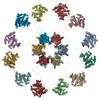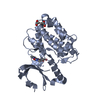+ Open data
Open data
- Basic information
Basic information
| Entry | Database: PDB / ID: 5u6y | ||||||
|---|---|---|---|---|---|---|---|
| Title | Pseudo-atomic model of the CaMKIIa holoenzyme. | ||||||
 Components Components | Calcium/calmodulin-dependent protein kinase type II subunit alpha | ||||||
 Keywords Keywords | TRANSFERASE / Calcium/calmodulin-dependent kinase II (CaMKII) / cell signaling / calcium / calmodulin (CaM) / long-term potentiation (LTP) / long-term depression (LTD) / synaptic plasticity / cooperativity / electron microscopy (EM) / single particle reconstruction / intrinsic disorder | ||||||
| Function / homology |  Function and homology information Function and homology informationregulation of synaptic vesicle docking / HSF1-dependent transactivation / RAF activation / Ion transport by P-type ATPases / peptidyl-threonine autophosphorylation / calcium- and calmodulin-dependent protein kinase complex / neurotransmitter receptor transport to plasma membrane / regulation of endocannabinoid signaling pathway / Interferon gamma signaling / Ca2+/calmodulin-dependent protein kinase ...regulation of synaptic vesicle docking / HSF1-dependent transactivation / RAF activation / Ion transport by P-type ATPases / peptidyl-threonine autophosphorylation / calcium- and calmodulin-dependent protein kinase complex / neurotransmitter receptor transport to plasma membrane / regulation of endocannabinoid signaling pathway / Interferon gamma signaling / Ca2+/calmodulin-dependent protein kinase / dendritic spine development / negative regulation of hydrolase activity / regulation of neurotransmitter secretion / Trafficking of AMPA receptors / regulation of neuron migration / positive regulation of calcium ion transport / GTPase activating protein binding / Ca2+ pathway / calcium/calmodulin-dependent protein kinase activity / RAF/MAP kinase cascade / regulation of mitochondrial membrane permeability involved in apoptotic process / Ion homeostasis / dendrite morphogenesis / regulation of neurotransmitter receptor localization to postsynaptic specialization membrane / regulation of neuronal synaptic plasticity / glutamate receptor binding / Unblocking of NMDA receptors, glutamate binding and activation / postsynaptic cytosol / regulation of protein localization to plasma membrane / cellular response to interferon-beta / positive regulation of cardiac muscle cell apoptotic process / presynaptic cytosol / dendrite cytoplasm / ionotropic glutamate receptor signaling pathway / response to ischemia / angiotensin-activated signaling pathway / positive regulation of receptor signaling pathway via JAK-STAT / G1/S transition of mitotic cell cycle / cellular response to type II interferon / Schaffer collateral - CA1 synapse / calcium ion transport / kinase activity / dendritic spine / calmodulin binding / neuron projection / postsynaptic density / axon / protein serine kinase activity / neuronal cell body / protein serine/threonine kinase activity / synapse / dendrite / glutamatergic synapse / protein homodimerization activity / mitochondrion / ATP binding / metal ion binding / identical protein binding / cytosol / cytoplasm Similarity search - Function | ||||||
| Biological species |  | ||||||
| Method | ELECTRON MICROSCOPY / single particle reconstruction / negative staining / Resolution: 20 Å | ||||||
 Authors Authors | Myers, J. / Reichow, S.L. | ||||||
| Funding support |  United States, 1items United States, 1items
| ||||||
 Citation Citation |  Journal: Nat Commun / Year: 2017 Journal: Nat Commun / Year: 2017Title: The CaMKII holoenzyme structure in activation-competent conformations. Authors: Janette B Myers / Vincent Zaegel / Steven J Coultrap / Adam P Miller / K Ulrich Bayer / Steve L Reichow /  Abstract: The Ca/calmodulin-dependent protein kinase II (CaMKII) assembles into large 12-meric holoenzymes, which is thought to enable regulatory processes required for synaptic plasticity underlying learning, ...The Ca/calmodulin-dependent protein kinase II (CaMKII) assembles into large 12-meric holoenzymes, which is thought to enable regulatory processes required for synaptic plasticity underlying learning, memory and cognition. Here we used single particle electron microscopy (EM) to determine a pseudoatomic model of the CaMKIIα holoenzyme in an extended and activation-competent conformation. The holoenzyme is organized by a rigid central hub complex, while positioning of the kinase domains is highly flexible, revealing dynamic holoenzymes ranging from 15-35 nm in diameter. While most kinase domains are ordered independently, ∼20% appear to form dimers and <3% are consistent with a compact conformation. An additional level of plasticity is revealed by a small fraction of bona-fide 14-mers (<4%) that may enable subunit exchange. Biochemical and cellular FRET studies confirm that the extended state of CaMKIIα resolved by EM is the predominant form of the holoenzyme, even under molecular crowding conditions. | ||||||
| History |
|
- Structure visualization
Structure visualization
| Movie |
 Movie viewer Movie viewer |
|---|---|
| Structure viewer | Molecule:  Molmil Molmil Jmol/JSmol Jmol/JSmol |
- Downloads & links
Downloads & links
- Download
Download
| PDBx/mmCIF format |  5u6y.cif.gz 5u6y.cif.gz | 1.8 MB | Display |  PDBx/mmCIF format PDBx/mmCIF format |
|---|---|---|---|---|
| PDB format |  pdb5u6y.ent.gz pdb5u6y.ent.gz | 1.6 MB | Display |  PDB format PDB format |
| PDBx/mmJSON format |  5u6y.json.gz 5u6y.json.gz | Tree view |  PDBx/mmJSON format PDBx/mmJSON format | |
| Others |  Other downloads Other downloads |
-Validation report
| Summary document |  5u6y_validation.pdf.gz 5u6y_validation.pdf.gz | 802.5 KB | Display |  wwPDB validaton report wwPDB validaton report |
|---|---|---|---|---|
| Full document |  5u6y_full_validation.pdf.gz 5u6y_full_validation.pdf.gz | 838.6 KB | Display | |
| Data in XML |  5u6y_validation.xml.gz 5u6y_validation.xml.gz | 126.2 KB | Display | |
| Data in CIF |  5u6y_validation.cif.gz 5u6y_validation.cif.gz | 201.3 KB | Display | |
| Arichive directory |  https://data.pdbj.org/pub/pdb/validation_reports/u6/5u6y https://data.pdbj.org/pub/pdb/validation_reports/u6/5u6y ftp://data.pdbj.org/pub/pdb/validation_reports/u6/5u6y ftp://data.pdbj.org/pub/pdb/validation_reports/u6/5u6y | HTTPS FTP |
-Related structure data
| Related structure data |  8514MC M: map data used to model this data C: citing same article ( |
|---|---|
| Similar structure data |
- Links
Links
- Assembly
Assembly
| Deposited unit | 
|
|---|---|
| 1 |
|
- Components
Components
| #1: Protein | Mass: 52281.535 Da / Num. of mol.: 12 Source method: isolated from a genetically manipulated source Source: (gene. exp.)   References: UniProt: P11275, Ca2+/calmodulin-dependent protein kinase |
|---|
-Experimental details
-Experiment
| Experiment | Method: ELECTRON MICROSCOPY |
|---|---|
| EM experiment | Aggregation state: PARTICLE / 3D reconstruction method: single particle reconstruction |
- Sample preparation
Sample preparation
| Component | Name: Calcium-calmodulin dependent kinase II alpha / Type: COMPLEX / Details: Full-length CaMKII alpha wild type / Entity ID: all / Source: RECOMBINANT | ||||||||||||||||||||
|---|---|---|---|---|---|---|---|---|---|---|---|---|---|---|---|---|---|---|---|---|---|
| Molecular weight | Value: 0.62 MDa / Experimental value: NO | ||||||||||||||||||||
| Source (natural) | Organism:  | ||||||||||||||||||||
| Source (recombinant) | Organism:  | ||||||||||||||||||||
| Buffer solution | pH: 7.4 | ||||||||||||||||||||
| Buffer component |
| ||||||||||||||||||||
| Specimen | Embedding applied: NO / Shadowing applied: NO / Staining applied: YES / Vitrification applied: NO / Details: 100 nM complex | ||||||||||||||||||||
| EM staining | Type: NEGATIVE / Details: 0.75% (wt/vol) uranyl formate / Material: Uranyl Formate | ||||||||||||||||||||
| Specimen support | Grid material: COPPER / Grid mesh size: 200 divisions/in. / Grid type: Ted Pella |
- Electron microscopy imaging
Electron microscopy imaging
| Microscopy | Model: FEI TECNAI 12 |
|---|---|
| Electron gun | Electron source: TUNGSTEN HAIRPIN / Accelerating voltage: 120 kV / Illumination mode: FLOOD BEAM |
| Electron lens | Mode: BRIGHT FIELD / Nominal magnification: 49000 X |
| Image recording | Average exposure time: 1 sec. / Electron dose: 20 e/Å2 / Film or detector model: FEI EAGLE (2k x 2k) |
- Processing
Processing
| EM software |
| ||||||||||||||||||||||||||||||||||||||||
|---|---|---|---|---|---|---|---|---|---|---|---|---|---|---|---|---|---|---|---|---|---|---|---|---|---|---|---|---|---|---|---|---|---|---|---|---|---|---|---|---|---|
| CTF correction | Details: Performed in EMAN2 / Type: PHASE FLIPPING AND AMPLITUDE CORRECTION | ||||||||||||||||||||||||||||||||||||||||
| Particle selection | Num. of particles selected: 16616 | ||||||||||||||||||||||||||||||||||||||||
| Symmetry | Point symmetry: D6 (2x6 fold dihedral) | ||||||||||||||||||||||||||||||||||||||||
| 3D reconstruction | Resolution: 20 Å / Resolution method: FSC 0.143 CUT-OFF / Num. of particles: 2000 Details: Only modeled the unstructured linker region, residues 300-345. The rest came from two other, previously published structures, namely 5IG3 and 2VZ6 Num. of class averages: 1 / Symmetry type: POINT | ||||||||||||||||||||||||||||||||||||||||
| Atomic model building | Protocol: RIGID BODY FIT / Target criteria: Correlation Coefficient | ||||||||||||||||||||||||||||||||||||||||
| Atomic model building | 3D fitting-ID: 1 / Source name: PDB / Type: experimental model
|
 Movie
Movie Controller
Controller



 UCSF Chimera
UCSF Chimera
 PDBj
PDBj






